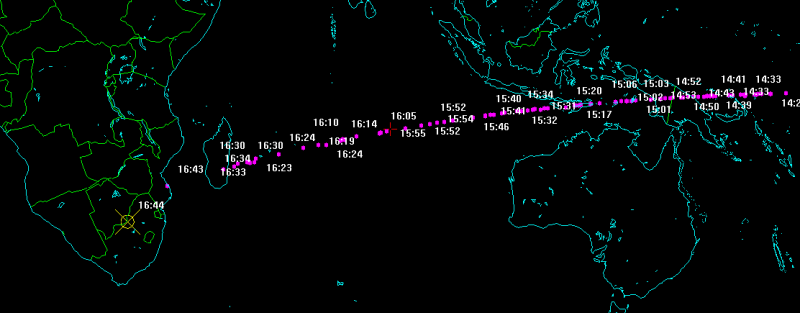The IAU has confirmed that the asteroid originally designated ZLAF9B2 – now called 2018 LA – disintegrated at a height of 30 miles (50 km) over South Africa on Saturday.
The International Astronomical Union has now confirmed that a small asteroid – discovered Saturday morning, June 2, 2018 – entered Earth’s atmosphere later that day. The asteroid was originally designated ZLAF9B2 and is now officially called 2018 LA. It surprised astronomers shortly after its discovery, when its trajectory suggested it would pass very, very close to Earth just hours later. The IAU confirmed:
The object reached 50-km [30-mile] height above the Earth’s surface around 16:51 UTC over southern Africa.
There are reports of sightings of a bright meteor, and a couple of video likely related to the event. The first video, above, is from Barend Swanepoel in South Africa. He reported the video as being:
… taken near my dad’s farm between Ottosdal and Hartbeesfontein.
Another video, taken from security footage from Farm Uitkyk, north of Vanzylsrus, Kalahari, also showed the meteor:
A witness in South Africa described the meteor as very bright, and showing a yellow color.
This space rock had an estimated size of only 10-16 feet (3 to 5 meters) in diameter. If it struck (and sometimes they do, and meteorite pieces are found), it was too small to cause serious damages. In contrast, the impressive meteor seen over Chelyabinsk, Russia, in February, 2013 was an estimated 60 feet wide (20 meters). It broke windows in six Russian cities and caused more than 1,500 people to seek medical attention, mostly due to injuries from flying glass. The June 2 asteroid wasn’t big enough to do anything like that, but it was big enough to produce a spectacular, very bright meteor.
The 60-inch (1.5-meter) telescope at Mt. Lemmon, which is part of the Catalina Sky Survey in Arizona, was the first to detect asteroid ZLAF9B2 on Saturday morning, according to clocks in North America. Alex Gibbs – principal engineer at the Catalina Sky Survey – posted these images of the object on his Facebook page:
According to NASA/JPL’s Center for Near Earth Object Studies (CNEOS), asteroid ZLAF9B2 approached Earth at 27,738 miles per hour (44,640 km per hour).
Models began suggesting that – in case of impact – the asteroid would enter Earth’s atmosphere somewhere between Indonesia, the Indian Ocean, or South Africa.

Trajectory models suggest small asteroid ZLAF9B2 impacted our atmosphere over South Africa on Saturday, and U.S. government sensors and satellites might confirm the event. Image via projectpluto.com.
The reported observation of the color yellow in the sighted meteor is of interest because colors in a meteor provide a hint of its composition. Yellow suggest the rock contains sodium, as was also in the 2013 Chelyabinsk meteor.
Small asteroids are difficult to detect. Some space rocks might be dark, and may only reflect a small amount of sunlight as they may already be somewhat close to our planet.
However, as bigger asteroids reflect more light, they are usually detected weeks or months before closest approach.
Confirmation of the event is continuing to trickle in:
Bottom line: Trajectory models suggest small asteroid ZLAF9B2 impacted Earth’s atmosphere over South Africa on Saturday, June 2, 2018.
Source: Earth Sky
































Leave a Comment
You must be logged in to post a comment.